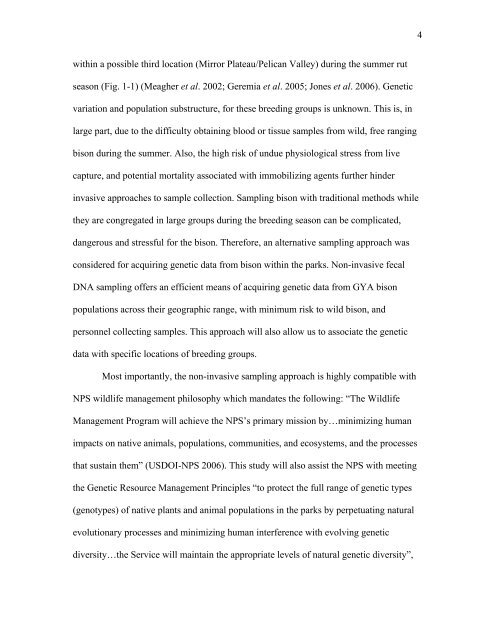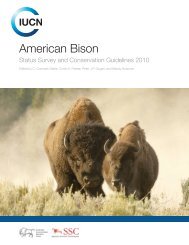Declaration Dr. Thomas H. Pringle - Buffalo Field Campaign
Declaration Dr. Thomas H. Pringle - Buffalo Field Campaign
Declaration Dr. Thomas H. Pringle - Buffalo Field Campaign
Create successful ePaper yourself
Turn your PDF publications into a flip-book with our unique Google optimized e-Paper software.
within a possible third location (Mirror Plateau/Pelican Valley) during the summer rut<br />
season (Fig. 1-1) (Meagher et al. 2002; Geremia et al. 2005; Jones et al. 2006). Genetic<br />
variation and population substructure, for these breeding groups is unknown. This is, in<br />
large part, due to the difficulty obtaining blood or tissue samples from wild, free ranging<br />
bison during the summer. Also, the high risk of undue physiological stress from live<br />
capture, and potential mortality associated with immobilizing agents further hinder<br />
invasive approaches to sample collection. Sampling bison with traditional methods while<br />
they are congregated in large groups during the breeding season can be complicated,<br />
dangerous and stressful for the bison. Therefore, an alternative sampling approach was<br />
considered for acquiring genetic data from bison within the parks. Non-invasive fecal<br />
DNA sampling offers an efficient means of acquiring genetic data from GYA bison<br />
populations across their geographic range, with minimum risk to wild bison, and<br />
personnel collecting samples. This approach will also allow us to associate the genetic<br />
data with specific locations of breeding groups.<br />
Most importantly, the non-invasive sampling approach is highly compatible with<br />
NPS wildlife management philosophy which mandates the following: “The Wildlife<br />
Management Program will achieve the NPS’s primary mission by…minimizing human<br />
impacts on native animals, populations, communities, and ecosystems, and the processes<br />
that sustain them” (USDOI-NPS 2006). This study will also assist the NPS with meeting<br />
the Genetic Resource Management Principles “to protect the full range of genetic types<br />
(genotypes) of native plants and animal populations in the parks by perpetuating natural<br />
evolutionary processes and minimizing human interference with evolving genetic<br />
diversity…the Service will maintain the appropriate levels of natural genetic diversity”,<br />
4










